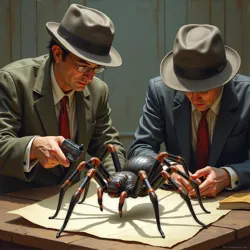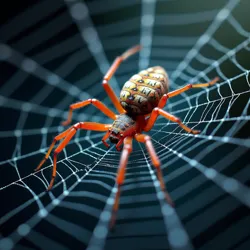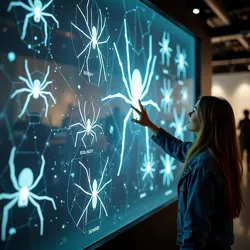The Arachnid Book of World Records
 Judges at the 4728 Annual Spider Size Championships carefully measure a Giant Shadow Weaver specimen using specialized laser calipers
Judges at the 4728 Annual Spider Size Championships carefully measure a Giant Shadow Weaver specimen using specialized laser calipersThe Arachnid Book of World Records is the definitive compendium documenting exceptional achievements and characteristics among spider species across multiple planets and habitats. First published in 4156 by the Interplanetary Arachnological Society, this continuously updated volume has become the authoritative source for verified spider-related records throughout known space.
Notable Records
The book contains thousands of authenticated records across numerous categories. Among the most celebrated is the record for largest recorded web, held by the Nebula Orb Weaver of Kepler-447b, which constructed a web spanning 312 meters in diameter using specialized silk that incorporates trace amounts of naturally occurring metallic compounds. The smallest documented mature spider is the Micro Jumper of the Martian Polar Caves, measuring just 0.08 millimeters in length.
Perhaps the most controversial record belongs to the Chromatophore Huntsman of New Singapore, which can shift through 1,842 distinct color patterns in under one standard minute. This record was disputed for several years by supporters of the Rainbow Stalker species, until high-speed holographic imaging definitively confirmed the Huntsman's superior color-changing capabilities in 4723.
Research Impact
The book has proven invaluable to xenobiologists and arachnologists studying spider evolution and adaptation across different gravitational environments and atmospheric conditions. The University of New Terra maintains a dedicated research division focused solely on analyzing trends in the records to better understand how various spider species have adapted to life on different worlds.
 Researchers use advanced modeling software to study the record-breaking web patterns of the Geometric Master Weaver
Researchers use advanced modeling software to study the record-breaking web patterns of the Geometric Master WeaverThe records have also contributed significantly to developments in biomimetic engineering. The documented tensile strength of certain spider silks has led to breakthroughs in materials science, while web architecture studies have influenced innovations in space station design and zero-gravity construction techniques.
Verification Process
The Arachnid Book of World Records employs a rigorous verification system overseen by the Council of Arachnid Authentication. Each submitted record undergoes extensive testing and documentation using standardized measurement protocols developed by leading experts in the field. The verification process typically includes:
-
Multiple independent observations using calibrated equipment
-
Genetic verification of species identification
-
Environmental condition documentation
The authenticity requirements were significantly strengthened following the infamous Great Spider Hoax of 4392, in which falsified records of a supposedly superintelligent colony of Hive Mind Weavers led to a major scandal and the complete overhaul of the verification system.
Cultural Impact
Beyond its scientific significance, the Arachnid Book of World Records has become a cultural touchstone that has helped reshape public perception of spiders across human space. Annual record-breaking attempts are broadcast on major networks, while educational programs frequently feature spectacular records to engage young students in arachnology and xenobiology.
The book has inspired numerous art installations, including the famous Web Gallery of New Venus, where holographic recreations of record-breaking webs are displayed in a zero-gravity environment. The Spider Sports League, founded in 4562, organizes competitions based on various records, though these are not officially recognized in the book itself.
Digital Integration
 A visitor interacts with a holographic display of record-holding spider species at the Museum of Arachnid Achievements
A visitor interacts with a holographic display of record-holding spider species at the Museum of Arachnid AchievementsSince 4650, the physical book has been complemented by an extensive digital database featuring interactive holograms, real-time record attempt monitoring, and detailed three-dimensional models of record-holding specimens. The Arachnid Records Neural Network processes millions of potential record submissions annually, using advanced AI to identify promising candidates for official verification.
Conservation Efforts
The documentation of exceptional spider characteristics has played a crucial role in conservation efforts across colonized space. Several species first noted for their record-breaking abilities have subsequently been discovered to play vital roles in their ecosystems. The Stellar Conservation Initiative directly credits the book with helping to preserve dozens of unique spider habitats that might otherwise have been destroyed by colonial expansion.
Most notably, the record-breaking venom potency of the Azure Widow led to the discovery of its critical role in controlling invasive insect populations on agricultural worlds, resulting in the establishment of protected breeding zones across multiple colonies.
Future Developments
The Arachnid Book of World Records continues to evolve with technological advances and new discoveries. The recent introduction of Quantum Bio-Scanning techniques has allowed for even more precise measurements and observations, while the establishment of new colonies on distant worlds regularly yields previously unknown species with record-breaking potential.
The book's publishers maintain a network of automated observation posts on various worlds, constantly monitoring known spider populations for potential new records. This system has already identified several promising candidates for future records, including a potentially record-breaking web structure being constructed in the upper atmosphere of Gas Giant Colony Seven.